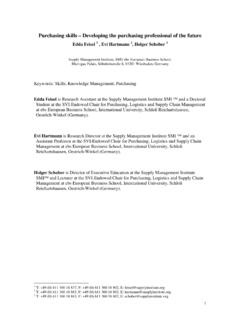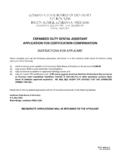Transcription of A NEW INTRODUCTION TO OLD NORSE PART II: READER
1 A NEW INTRODUCTION TO OLD NORSEPART II: READERA NEWINTRODUCTION TOOLD NORSEPART IIREADERFOURTH EDITIONEDITED BYANTHONY FAULKESVIKING SOCIETY FOR NORTHERN RESEARCHUNIVERSITY COLLEGE LONDON2007 VIKING SOCIETY FOR NORTHERN RESEARCHISBN: 978-0-903521-69-7 First published 2001 Printed by Short Run Press Limited, ExeterSecond edition with corrections and additions 2002 Third edition with corrections and additions 2005 Fourth edition with corrections and additions 2007 Reprinted with minor corrections 2008 PREFACEThis fourth edition of A New INTRODUCTION to Old NORSE , part II: Readercontains, in addition to all those in previous editions, nine new texts:extracts from The Book of Settlements, the Saga of Eir kr the Red (aboutan expedition to V nland), Nj ls saga, a law-book (Gr g s), a learnedtext (treatise on physiognomy), examples of Old Danish and OldSwedish writings and the Norwegian King s Mirror; and two completepoems, another eddic (heroic) poem (Ham ism l) and the r ma aboutSt l fr.
2 The vocabulary of these texts is included in the fourth editionof part III: Glossary and Index of texts have been prepared and annotated by the following:I , XVII and XX: Michael , XVI and XIX: Anthony , VIII, XXI and XXVII: Richard , IX, X, XI and XXIV: Rory , VI, XV and XXVI: Alison : Diana and XXIII: David and XXII: Carl : Peter : Elizabeth Ashman : John introductions are by the same writers, except in the case of Text is by Anthony Faulkes, who has also been general editor of thewhole volume, and compiled the main Glossary and Index in PartIII, the fourth edition of which includes supplementary Glossariesand Indexes to the East NORSE texts and the runic inscriptions byMichael Barnes. The general INTRODUCTION to the Study of Old NORSE is by Alison plan of this volume was that it should include at least one extractfrom works in each of the main genres of Old NORSE literature. Thisplan has now been fulfilled, and NION now offers an INTRODUCTION tothe whole range of early Scandinavian writings.
3 Users of this bookare reminded that several further complete Old Icelandic texts withglossaries are available in other Viking Society publications (seep. xxxiv below).The first part of Text I, the extract from Hr lfs saga, has a compre-hensive grammatical commentary. The remainder of the extract is fullyglossed with virtually complete references. It is recommended thatviA New INTRODUCTION to Old Norsestudents begin with this text to ensure that they understand thegrammatical structure of Old Icelandic before proceeding to otherswhere the grammatical information in the glossary and notes is muchsparser. The succeeding texts are glossed with progressively fewerreferences, though it is hoped that all words have been explained ontheir first occurrence in each extract, so that it will not be necessaryfor them to be read in the order in which they are printed. Idioms andconstructions are explained much more fully in the Glossary than isusual in teaching books because experience has shown that it is thesethat cause the greatest difficulty in understanding Old Icelandic texts;and numerous cross-references are included to help elementary studentsidentify the entry forms of words that appear in the texts in guises thatare difficult to recognise another of the persistent problems of learn-ing this , of both texts and textual notes, has been normalised, usingthe symbols listed in NION I, (with the addition of for the short open e in Old Norwegian).
4 This also applies to the verses,and the language of these has not been archaised as has been thecustom in most previous editions. Word forms have on the whole notbeen changed from what appears in the manuscripts, either to conformto what is believed to have been normal in the early thirteenth centuryfor early sagas or to replace the modern forms that appear in latemanuscripts ( in those of Hr lfs saga); or to replace the Norwegianforms that appear in Fagrskinna and Konungs skuggsj . This is in-tended to help students to become accustomed to the wide variety offorms (archaic, dialectal, post-classical or analogical) that appearcommonly in editions (and dictionaries and grammars), and also toensure that they are aware of the different forms that underlie thenormalised texts that have traditionally been used in teaching, and ofthe variations in the language between AD 900 and 1400 over the widecultural area inhabited by Vikings in the Middle Ages.
5 It should alsomake it easier for them to progress to independent reading of textswhere the language is not fully normalised. All such variant formsare included in the Glossary in NION III, with cross-references to the base texts have been marked by pointed brackets around letters added to the manuscript readings, square brackets [ ]around letters supplied that are illegible and italics for letters changed(the manuscript readings in the last case are given in footnotes). INTRODUCTION to the study of Old NorseviiCONTENTSABBREVIATIONS .. viiiINTRODUCTION TO THE STUDY OF OLD NORSE .. ixCHRONOLOGY .. xxxviiMAP OF ICELAND .. xlLIST OF LAWSPEAKERS .. xliiI:HR LFS SAGA KRAKA .. 1II:Snorri Sturluson: EDDA .. 15 III:Sturla fi r arson: SLENDINGA SAGA .. 23IV:KORMAKS SAGA .. 35V:BJARNAR SAGA H TD LAKAPPA .. 43VI:FAGRSKINNA .. 55 VII:Snorri Sturluson: HEIMSKRINGLA .. 79A: L FS SAGA TRYGGVASONAR .. 82B: HARALDS SAGA SIGUR ARSONAR .. 89C: THE ART AND CRAFT OF THE SKALDIC STANZA.
6 94 VIII:Ari fiorgilsson: SLENDINGAB K .. 99IX:fiRYMSKVI A .. 127X:V LUNDARKVI A .. 141XI:fiI REKS SAGA .. 155 XII:SAGA AF TRISTRAM OK S ND .. 163 XIII:MAR U SAGA .. 173 XIV:J NS SAGA HELGA .. 179XV:LAXD LA SAGA .. 191 XVI:AU UNAR fi TTR .. 201 XVII: RUNIC INSCRIPTIONS .. 211 XVIII: M RUVALLAB K .. 239 XIX:LANDN MAB K .. 255XX:EAST NORSE .. 261 XXI:EIR KS SAGA RAU A .. 281 XXII: L FS R MA HARALDSSONAR .. 307 XXIII: PHYSIOGNOMY .. 323 XXIV: KONUNGS SKUGGSJ .. 333 XXV: HAM ISM L .. 343 XXVI: NJ LS SAGA .. 363 XXVII: GR G S .. 381 ABBREVIATIONSBS = The Book of the Settlements. Landn mab k, tr. Hermann P lsson andPaul Edwards (1972).CCIMA = Corpus Codicum Islandicorum Medii Aevi I XX (1930 56).CSI = The Complete Sagas of Icelanders I V, ed. Vi ar Hreinsson et al. (1997).C V = Richard Cleasby and Gudbrand Vigfusson, An Icelandic EnglishDictionary. 2nd ed. by William A. Craigie (1957).DMA = Dictionary of the Middle Ages, ed. Joseph R. Strayer, 13 vols (1982 89).
7 E S = Einar l. Sveinsson, The Age of the Sturlungs: Icelandic Civilizationin the Thirteenth Century, tr. J hann S. Hannesson (1953).Gr = Michael Barnes, A New INTRODUCTION to Old NORSE . part I. Grammar(2004).Hkr = Snorri Sturluson, Heimskringla. History of the Kings of Norway, M. Hollander (1964 and reprints).HOIC = J n J hannesson, A History of the Old Icelandic Commonwealth, Bessason (1974). F = slenzk fornrit I , 1933 .ION = E. V. Gordon, An INTRODUCTION to Old NORSE . 2nd ed. by A. R. Taylor(1957).Laws = Laws of Early Iceland. Gr g s I II, tr. Andrew Dennis, Peter Foote,Richard Perkins (1980 2000).LP = Sveinbj rn Egilsson, Lexicon Poeticum, rev. Finnur J nsson (1931).MRN = E. O. G. Turville-Petre, Myth and Religion of the North (1964 andreprints).MS = Phillip Pulsiano (ed.), Medieval Scandinavia: An Encyclopedia (1993).NION = A New INTRODUCTION to Old T = Saga l fs Tryggvasonar af Oddr Snorrason munk, ed. FinnurJ nsson (1932).ON = Old = Edda: die Lieder des Codex Regius nebst verwandten Denkm lern, Neckel, 4th ed.
8 , rev. Hans Kuhn (1962).Skj = Den norsk-islandske skjaldedigtning A I II, B I II, ed. Finnur J nsson(1912 15).SnE, Gylfaginning = Snorri Sturluson, Edda. Prologue and Gylfaginning, Faulkes (2005).SnE, H ttatal = Snorri Sturluson, Edda. H ttatal, ed. Anthony Faulkes (1999).SnE, Sk ldskaparm l = Snorri Sturluson, Edda. Sk ldskaparm l, ed. AnthonyFaulkes (1998).VAch = Peter Foote and David M. Wilson, The Viking Achievement (1970). INTRODUCTION TO THE STUDY OF OLD NORSE1. Old NORSE or Old Icelandic?The main aim of this READER , and ultimately of A New INTRODUCTION toOld NORSE as a whole, is to introduce students to representative extractsfrom works in each of the major genres of literature surviving in OldIcelandic, along with the necessary apparatus for reading these textsin their original language. This INTRODUCTION offers a brief overviewof these genres, together with an account of their context. Somebibliographical references are given at the end of each section, andmore general suggestions for further reading are listed at the end ofthis INTRODUCTION , but these bibliographies are not exhaustive, and tendto favour works available in English.
9 More specific introductorymaterial and bibliographical suggestions can be found in the Intro-duction to each text in the term Old NORSE has traditionally been used to refer to thelanguage, literature and culture of medieval Scandinavia in the MiddleAges. Some scholars condemn the term as an appropriation of theculture and heritage of Iceland, and prefer the label Old Icelandic ,since virtually all the surviving literary texts were either written inIceland, or are preserved only in Icelandic manuscripts (J nasKristj nsson 1994). But Old NORSE does capture the fact that thisliterary heritage ultimately represents a culture originating in mainlandScandinavia, which was taken during the Viking Age (see 2 below)not only to the Viking colonies, including Iceland, that were estab-lished in the Atlantic, but also as far afield as Greenland and NorthAmerica. According to accounts in the sagas, the impetus for thesettlement of these colonies came primarily from Norway, thoughattempts have been made to gauge the accuracy of this account byscientific means, and to argue for a strong Celtic element in the earlyIcelandic population.
10 The picture of strong cultural links betweenNorway, Iceland and settlements in Orkney, the Hebrides and northernBritain (including Ireland) has not been seriously challenged. Thelanguage of Norway and its colonies is referred to as West NORSE , todistinguish it from East NORSE , the language of Sweden and an account of the term Old NORSE as it applies to the language,see Grammar, INTRODUCTION from the runic inscriptions in Text XVII, the texts includedin this READER have an Icelandic emphasis, which reflects thexA New INTRODUCTION to Old Norsepredominance of the Icelanders in recording the history of theScandinavian peoples, developing new literary forms, and preservingtexts of many kinds through copying and reworking over manycenturies. But Texts VI, XI and XXIV originated in Norway and aselection of East NORSE extracts is included in Text those primarily interested in the material culture the historyor archaeology that comes within the sphere of Old NORSE willfind themselves extrapolating information from Icelandic texts.













